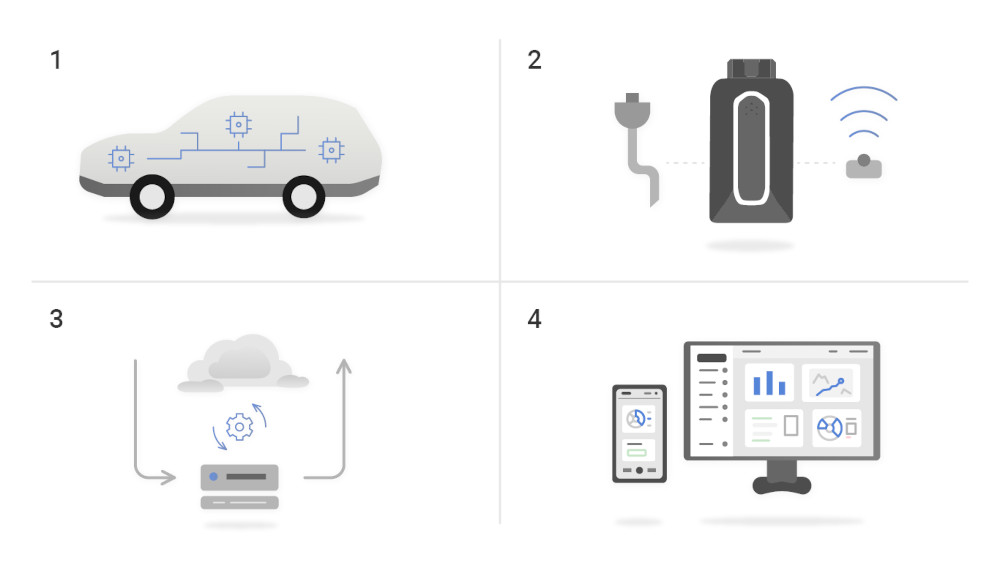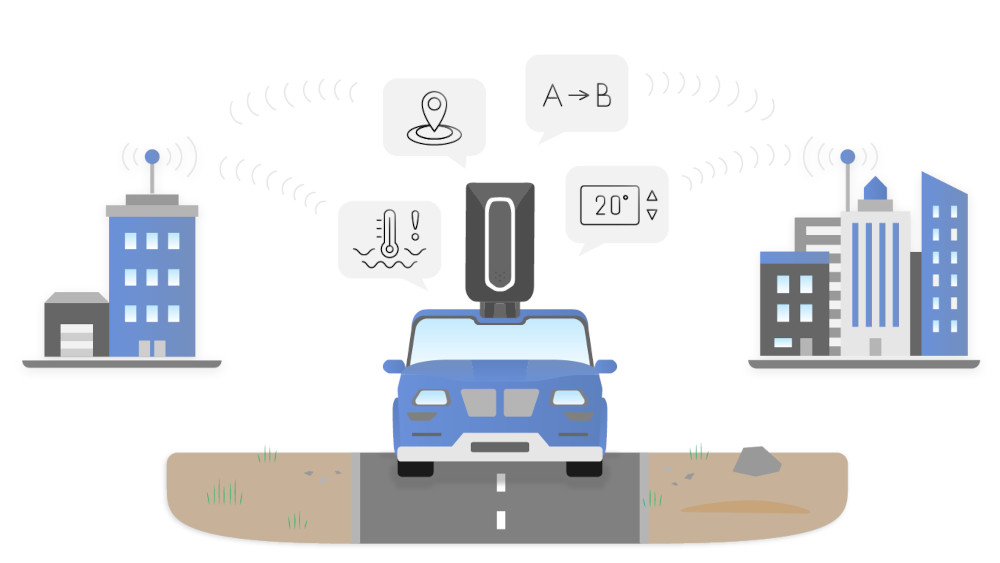Telematics systems are transforming our cars, making them more than just vehicles.
These systems blend telecommunications and data analytics to enhance how cars operate and communicate with the world. Essentially, they turn data from the car's GPS and onboard sensors into valuable insights about everything form location to vehicle health.
Why does this matter? Because it means better safety, smarter maintenance, and more efficient driving. Whether you're a car enthusiast or manage a fleet of vehicles, understanding the technology behind telematics can make a big difference.
Our engineers at AutoPi have over two decades of combined experience in the tech and automotive industries, and they are eager to share their knowledge on telematics. We’ll explore everything from the basic components to the latest innovations that are shaping the future of driving.
So, let’s dive into the world of telematics, uncovering how these systems work and the amazing benefits they bring to our driving experience.
What is a Telematics System?
A telematics system blends telecommunications and informatics to monitor and manage vehicles from a distance. This setup uses advanced technology to collect, process, and analyze vehicle data, ensuring everything from vehicle location to engine health is continually tracked.
Core Components of a Telematics System
Telematics Control Unit (TCU): This is the brain of the system, handling all the data your vehicle generates. It uses communication modules like GSM or LTE, along with GPS, to send and receive information. The TCU collects data from the vehicle's sensors, secures it, and then sends it over cellular networks to a server.
Global Positioning System (GPS) Module: This component keeps track of the vehicle's precise location using satellites. It's crucial for services like real-time tracking and route planning.
Onboard Diagnostics (OBD-II) Interface: Connected to the vehicle's diagnostics system, this interface pulls detailed data about the vehicle's operation, such as engine status and fuel usage. It's essential for spotting potential issues early and for routine maintenance.
Communication Infrastructure: Telematics systems use modern, secure communication protocols to transmit data.
Advanced Functionalities in Telematics
Telematics isn't just about data collection; it's also about smart data processing.
With edge computing, data can be analyzed right on the device, speeding up decision-making processes and reducing costs. Plus, machine learning algorithms help predict maintenance needs and adjust routes on the fly based on live traffic data.
AutoPi Cloud: The AutoPi Cloud is where all your vehicle data comes to be organized and stored. It’s like a central library that keeps everything in order for easy access.
Telematics systems significantly enhance how we manage and interact with vehicles. They combine detailed data collection with powerful tools to improve safety, efficiency, and compliance across the board.
How Telematics Systems Work
To appreciate the sophistication and capabilities of modern telematics systems, it's important to understand their operational mechanics. In this section, we provide an in-depth look at how our telematics system works at AutoPi, illustrating the technology and expertise behind its design.
-
Sensor Activation: When the vehicle starts, the AutoPi device activates its sensors, including GPS modules, accelerometers, and various engine monitoring sensors.
-
Data Gathering: These sensors collect data at high frequencies. For instance, GPS data are logged every second to provide precise tracking, while engine parameters like RPM and temperature are monitored continuously to detect any signs of irregularities.
-
Initial Processing: The data collected are initially processed by AutoPi’s onboard Telematics Control Unit (TCU), which performs data normalization and encryption. This step is crucial to prepare the data for secure transmission.
-
Data Sending: Encrypted data packets are transmitted via a secure LTE connection to the AutoPi cloud server. The use of advanced encryption protocols ensures the integrity and confidentiality of the data as it travels over the internet.
-
Data Reception: Upon arrival at the cloud server, data packets are decrypted and processed for storage. This processing includes data validation and timestamping to ensure accuracy and traceability.
-
Data Management: The AutoPi Cloud organizes the data into a user-friendly format. While it does not perform data analytics, it provides powerful tools for users to access and manage their data effectively, ensuring that vehicle operators can easily retrieve the information they need when they need it.
-
Access and Use: Operators access the telematics data through the AutoPi user interface, which offers a comprehensive dashboard view of real-time and historical data. For example, fleet managers can monitor vehicle health reports and receive alerts for preventive maintenance, thereby minimizing downtime and operational costs.
The whole process can be boiled down into 4 stages: Data Collection, Data Transmission, Data Reception and Management, and Utilization.

Technical Expertise and Security
The development of the AutoPi telematics system leverages over two decades of combined expertise in automotive technology and data security. Our engineers ensure that every component of the system meets the highest standards of technical excellence and security compliance.
This example of how the AutoPi telematics system operates demonstrates the complexity and effectiveness of our solution. By integrating advanced telecommunications and informatics, AutoPi provides a robust platform that enhances vehicle management and improves operational efficiencies.
Key Technologies in Telematics
Telematics technology evolving fast, thanks to several breakthroughs that make these systems more effective and responsive.
Here's our perspective on key innovative developments that are reshaping how we manage vehicles.
Real-time Data Processing
Imagine a telematics system that reacts instantly to traffic changes or issues with your vehicle. That's what real-time data processing enables. It means your system can adjust your route right away if there’s a traffic jam ahead or alert you instantly if something goes wrong with your vehicle.
Machine Learning and Predictive Analytics
Machine learning is like giving your telematics system a crystal ball. It uses past data to predict future needs. For instance, by understanding patterns in engine performance, the system can predict when your vehicle might need servicing, helping you avoid a breakdown and save on repairs.
Enhanced GPS Accuracy
Today’s GPS technology is incredibly precise. It can pinpoint your vehicle's location to within a few meters, making it easier than ever to track routes accurately, manage tolls automatically, or ensure deliveries are spot-on. This precision is crucial for managing everything from daily commutes to complex fleet logistics.
Internet of Things (IoT) Integration
By integrating with the Internet of Things, vehicles become smarter and more connected. This means your vehicle can communicate with traffic lights, road sensors, and even other cars to optimize your driving experience. This connectedness makes the whole transportation system more efficient.
Blockchain for Security and Transparency
Blockchain might sound complex, but its benefit for telematics is straightforward: it makes your data secure and transparent. By recording data like vehicle logs and driver behaviors on a blockchain, the system ensures that this information is tamper-proof and easily verifiable, which is crucial for maintaining integrity and compliance.
These technologies are driving the future of telematics, making vehicles safer, more efficient, and better connected. As these technologies advance, they'll continue to transform the landscape of automotive management.
The Future of Telematics Systems
The future of telematics is bright and bustling with innovations, guided by the brightest minds in technology and automotive industries.
Here’s what we can expect:
Artificial Intelligence (AI): AI will take telematics to new heights. Imagine systems that don’t just collect data but also think and make smart decisions on their own. This means cars that can predict and adapt to driving conditions even before you notice anything is amiss.
Vehicle-to-Everything (V2X) Communication: The V2X technology is all about connection. Soon, cars will be able to talk to each other and even to the road they're on. This will help prevent accidents and manage traffic much more smoothly, thanks to real-time data from the surrounding environment.
Customization and Personalization: Future telematics will know you better. Your car will suggest routes, maintenance, and even safety features tailored just for you, based on how you drive and what you like.
Stronger Data Security: As cars get smarter, they also need to be safer from digital threats. Upcoming telematics systems will have cutting-edge security measures to keep your data safe, ensuring privacy and trust as you drive.
These exciting advancements are being developed right now by teams of experts at AutoPi and beyond. They’re working hard to turn these visions into reality, ensuring that the future of driving is not only smarter but also safer and more personalized.

Challenges and Considerations in Telematics System
As telematics systems become more advanced and common in vehicles and transport systems, they bring new challenges. It's important to tackle these to keep telematics growing in a healthy way.
|
Challenge
|
What It Means
|
What We Can Do
|
Why It Matters
|
|---|---|---|---|
| Data Privacy and Security | Keeping data safe from hackers. | Improve encryption and secure how data is sent and stored. | To keep users' trust and meet privacy laws. |
| System Reliability | Making sure the system always works right. | Use better sensors and have backup systems in place. | To make sure the data is always accurate and reliable. |
| Interoperability | Getting different systems to work together. | Create common standards so different systems can communicate. | To make it easier to use and combine different systems. |
| Regulatory Compliance | Following the law. | Work closely with lawmakers, stay updated on new laws. | To ensure telematics is used legally and ethically. |
| Cost and Scalability | Making it affordable and able to grow. | Develop solutions that are cost-effective and can expand easily. | To allow more people and businesses to use telematics. |
This table highlights each challenge in telematics, what actions can be taken, and why these actions are important.
Legal and Regulatory Considerations Impacting Telematics Systems
As telematics technology becomes a bigger part of our transportation systems, understanding and following the legal and regulatory rules is crucial. It’s not just about obeying laws—it’s about using telematics ethically and responsibly.
Telematics systems face a lot of different rules, depending on where you are. For example, Europe’s GDPR requires strict handling of personal data and gives people more control over their information (EU GDPR Portal, 2022). In the U.S., California’s CCPA offers similar protections, focusing on how personal information is accessed, deleted, and shared (California Department of Justice, 2022).
There are also rules about how telematics devices work and connect. These can include certifications for the devices themselves or regulations about how they use wireless networks. Keeping up with these rules means constantly checking for updates and changes.
Experts in the field suggest that being proactive and involved in discussions about policy and standards can help shape these rules in a way that supports innovation while keeping public interests safe (International Journal of Automotive Technology, 2021).
Staying ahead of these legal aspects helps build trust and ensures that telematics systems are not only useful but also safe and fair.
Conclusion
Telematics systems are transforming our driving experience, making vehicles smarter and more connected than ever before. As we've seen, these systems use cutting-edge technology to provide valuable insights about vehicle performance, enhance safety, and boost efficiency.
Despite the clear benefits, there are challenges to tackle—like ensuring data privacy, maintaining system reliability, and meeting regulatory standards. Addressing these issues head-on is key to the successful expansion of telematics technology.
Looking ahead, the potential of telematics to reshape transportation is exciting. It promises safer roads, more efficient businesses, and enhanced enjoyment of our vehicles.
Interested in what telematics can do for you or your business? Get in touch with us! We're here to help you explore innovative telematics solutions tailored to your needs. Contact us today and start your journey toward a smarter, more connected driving experience.






